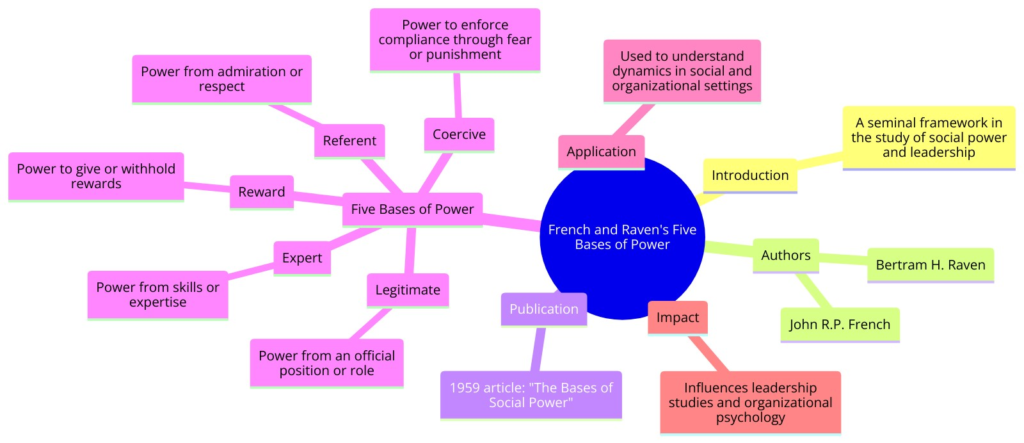Five Bases of Power
French and Raven’s Five Bases of Power is a seminal framework in the study of social power and leadership, introduced by social psychologists John R.P. French and Bertram H. Raven in their 1959 article, “The Bases of Social Power.” This model categorizes the sources of power that leaders and individuals within organizations wield to influence behavior, highlighting how different forms of power affect leadership effectiveness and interpersonal dynamics.
What are French and Raven’s Five Bases of Power?
French and Raven identified five distinct bases of power, later expanded to six, each stemming from different sources within the organization or the leaders themselves:
- Reward Power: Based on the ability to control the allocation of rewards valued by others and to remove negative sanctions. Individuals comply because doing so leads to positive benefits.
- Coercive Power: Derived from the ability to inflict punishments or remove rewards. Compliance is motivated by the desire to avoid negative consequences.
- Legitimate Power: Stems from the formal authority to command and make decisions. It is based on the position of an individual within an organization’s hierarchy.
- Expert Power: Comes from the leader’s expertise, skill, or knowledge. Others comply because they believe in, can learn from, or can otherwise gain from following the leader’s guidance.
- Referent Power: Based on the leader’s personal traits and relationships with others. This power emerges when others identify with, like, admire, or respect the leader.
A sixth base, Informational Power (sometimes considered a sub-type of expert power), was later added to account for the influence one can wield through the control of valuable information.
Why It Is Valuable
French and Raven’s framework offers several key benefits for understanding leadership and organizational behavior:
- Insight into Influence Mechanisms: It provides a clear understanding of how different forms of power can be used to influence others’ behavior and attitudes.
- Enhanced Leadership Effectiveness: By recognizing the different bases of power, leaders can adapt their approach to be more effective in various situations.
- Improved Organizational Dynamics: The framework helps in diagnosing power dynamics within organizations, facilitating more effective communication and conflict resolution.
- Personal Development: Individuals can become more aware of the sources of power they rely on and work to develop a more balanced approach, leveraging more positive forms of power.
When and How to Use It
Understanding the five bases of power can enhance leadership practices, conflict resolution, negotiation, and overall organizational effectiveness. Leaders and managers can use this framework to:
- Reflect on their own sources of power and how they are utilized in interactions with team members.
- Develop strategies that emphasize positive forms of power (like expert and referent power) to foster motivation and commitment.
- Recognize and address the implications of relying too heavily on coercive or reward power, which can lead to compliance but not genuine engagement.
- Train and mentor others in the organization to understand and use power more effectively.
Shortcomings/Criticisms
While widely influential, French and Raven’s model has been subject to criticism:
- Over-Simplification: Critics argue that the model oversimplifies the complex nature of power dynamics within organizations.
- Contextual Limitations: The effectiveness of each power base can vary significantly depending on the cultural, organizational, and situational context, which the original model does not fully address.
- Ethical Considerations: The model does not inherently distinguish between ethical and unethical uses of power, leaving room for potential misuse if not guided by ethical considerations.
The French and Raven’s Five Bases of Power provides a foundational framework for understanding the sources and implications of power within organizational and leadership contexts. By offering insights into how different forms of power influence behavior and relationships, the model serves as a valuable tool for leaders seeking to enhance their influence and effectiveness. However, it is important to apply this knowledge ethically and consider the broader context in which power dynamics unfold.


